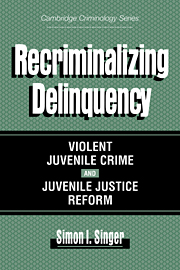Book contents
- Frontmatter
- Contents
- List of Figures and Tables
- Acknowledgments
- Introduction
- 1 Recriminalizing Violent Juvenile Crime
- 2 Taking Stock of Juvenile Justice Reforms
- 3 Recriminalization on the Move and Its Legal Rules
- 4 Contextual and Legal Reasons for Identifying Juveniles as Criminal Offenders
- 5 The Case Processing of Juvenile Offenders: From Arrest to Disposition
- 6 Recriminalization and Organizing for Deterrence
- 7 Convicted Juvenile Offenders in a Maximum Security Institution
- 8 Concluding “Real” Reasons for Recriminalizing Delinquency
- Appendixes
- Notes
- References
- Index
4 - Contextual and Legal Reasons for Identifying Juveniles as Criminal Offenders
Published online by Cambridge University Press: 29 September 2009
- Frontmatter
- Contents
- List of Figures and Tables
- Acknowledgments
- Introduction
- 1 Recriminalizing Violent Juvenile Crime
- 2 Taking Stock of Juvenile Justice Reforms
- 3 Recriminalization on the Move and Its Legal Rules
- 4 Contextual and Legal Reasons for Identifying Juveniles as Criminal Offenders
- 5 The Case Processing of Juvenile Offenders: From Arrest to Disposition
- 6 Recriminalization and Organizing for Deterrence
- 7 Convicted Juvenile Offenders in a Maximum Security Institution
- 8 Concluding “Real” Reasons for Recriminalizing Delinquency
- Appendixes
- Notes
- References
- Index
Summary
i now shift my focus from the JO law's creation to its implementation. Yet I do not want to shift gears completely because the reasons for the JO law's implementation are similar to those cited for its creation. They are to avoid and to confront crisis. What kind of crisis? Well, the sort of crisis that can suddenly lead officials to create waiver legislation, such as when Governor Carey learned that Willie Bosket was responsible for the murder of subway passengers. But the creators of the JO law are not alone in their attempt to control and avoid crisis. The police, prosecutors, and judges arrest, charge, and sentence juveniles as offenders in criminal court instead of as delinquents in juvenile court, because they want to control and avoid their repeated acts of delinquency and crime. And just as there are political and organizational interests and concerns that lead to the creation of the JO law, so too are there factors that go beyond the offense and offender characteristics to explain the law's implementation.
In the following sections, I first draw on principles that have been used to identify juvenile court decision making to illustrate the legal reasons for assigning criminal responsibility to juveniles. Next I relate part of the context in which juveniles may be considered offenders instead of delinquents. I then conclude this chapter with several sources of data to explain the context in which juveniles are initially labeled as offenders in the adult criminal justice process.
- Type
- Chapter
- Information
- Recriminalizing DelinquencyViolent Juvenile Crime and Juvenile Justice Reform, pp. 75 - 96Publisher: Cambridge University PressPrint publication year: 1996



